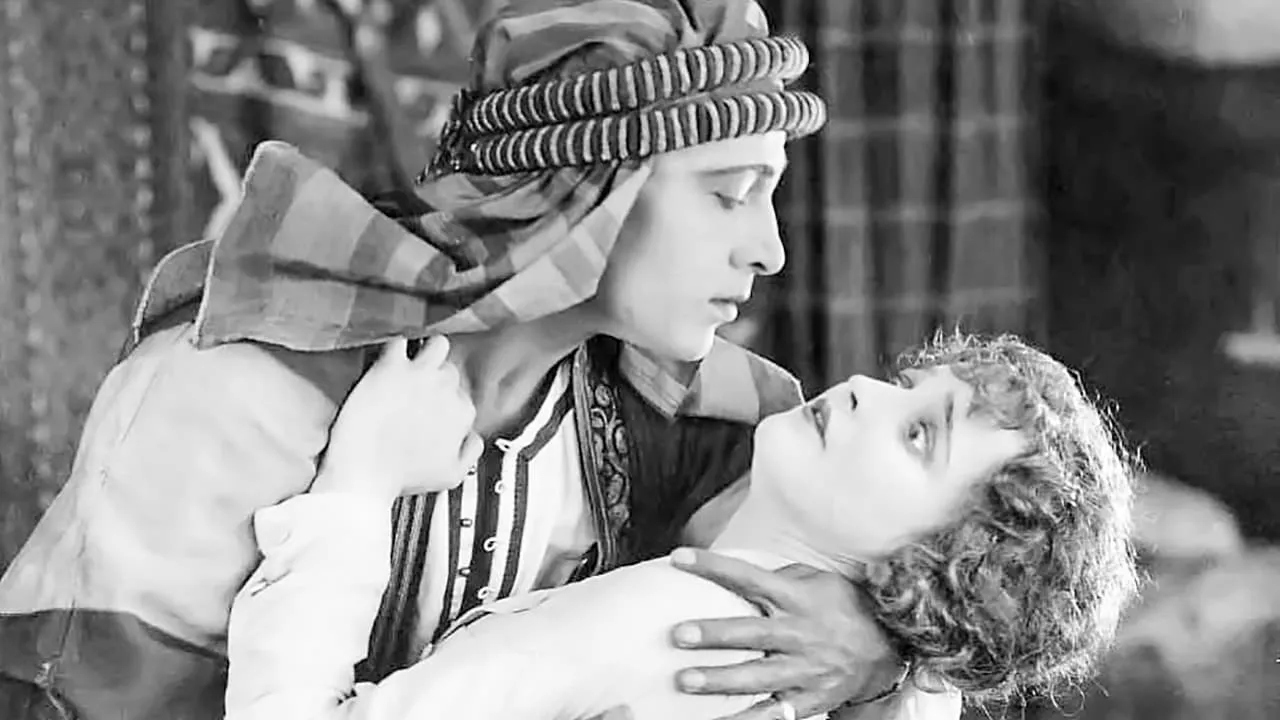
Certain films that were made more than century ago are impossible to make now, merely because certain details of their content would be absolutely unacceptable to certain very loud segments of today’s audience. This might involve even films that used to be among the biggest hits and later became some of the most iconic works of silent Hollywood, like The Sheik, 1921 romantic drama produced and directed by George Melford.
The film is based on the bestselling 1919 novel by British writer Edith Maud Hull. The plot begins in Biskra, city in Algerian desert, where adventurous tomboyish young British aristocrat Diane Mayo (played by Agnes Ayres) refuses men’s marriage proposals, determined to preserve her independence. Much to the displeasure of her brother Sir Aubrey Mayo (played by Fredric Butler), she decides to take a month long trip into interior of Sahara. In the meantime, Biskra is visited by Sheikh Ahmed Ben Hasan (played by Rudolph Valentino), chief of a tribe of desert nomads who came in order to gamble for his tribesmen’s wives at local casino. Intrigued by strange local customs, Diane dresses as Arab woman in order to witness proceedings and, in the process, she catches Ahmed’s attention. He immediately hatches plan to kidnap her and does so when she gets into desert. She is at first revolted by her situation and even more so when her captivity is going to be witnessed by Raoul de Saint Hubert (played by Adolphe Menjou), French novelist who befriended Ahmed during his education in Paris. He ultimately talks Ahmed into releasing Diane, but she gets snatched by bandit chief Omair (played by Walter Long). Only then she realises that she fell in love with her captor, while Ahmed leads dangerous raid to set her free.
The Sheik is best known role in the filmography of Rudolph Valentino, one of the top stars of silent Hollywood and greatest icons of 1920s popular culture. During production he has already enjoyed stardom due to his breakout performance in The Four Horsemen of the Apocalypse, made few earlier. But it was The Sheik that made him into global phenomenon. Valentino in the film employed his good looks and exotic image of “Latin lover” with just enough hints of “bad boy” persona to easily win millions of women in the audience. This made Sheikh Ahmed Ben Hassan into Valentino’s most iconic role, creating an image with which he is associated to this day. This, on the other hand, isn’t Valentino’s best role. While he did the solid job, he didn’t have an opportunity to develop talents that he would show in his later films, mostly due to role being relatively simple and stereotypical. Agnes Ayres, who was actually credited over Valentino, had much more demanding job in more complex (and from today’s perspective thankless) role of a woman who starts as independent proto-feminist only to succumb to raw power of patriarchy embodied in Valentino. The Sheik also features Adolphe Menjou, actor who would later have many notable character roles in sound films, in more than decent role of Ahmed’s friend, while future Hollywood star Loretta Young, then aged 8, appears in small role of Arab girl.
The Sheik might anger some viewers who would see it as an attempt of “whitewashing” through casting Italian actor in a role of an Arab. The film, just like the novel, finds convenient way around it by having Ahmed described as European adopted by Arab tribe as a child. The more problematic aspect of the film might be found in the script by Monte M. Katterjohn, which conforms to some of the Orientalist stereotypes in portrayal of Arab culture. Even more problematic is the script that starts with strong female protagonist who ultimately accepts her submission to a man, which is likely to infuriate today’s feminists. Much more valid argument against this film can be found in uninspired direction by George Melford, which relies too much on static shots and employs unsatisfactory editing, especially in the first part of the film, which is slightly overlong. The Sheik nevertheless quickly became big hit and part of popular culture, with “Sheik of Araby”, song directly inspired by film, becoming one of the big pop standards of Jazz Age and the word “sheik” entering popular slang as synonym for predatory seducers. Popularity of the film led to production of 1926 sequel The Son of the Sheik, released shortly after Valentino’s death.
RATING: 5/10 (++)
Blog in Croatian https://draxblog.com
Blog in English https://draxreview.wordpress.com/
Leofinance blog @drax.leo
Unstoppable Domains: https://unstoppabledomains.com/?ref=3fc23fc42c1b417
Hiveonboard: https://hiveonboard.com?ref=drax
Bitcoin Lightning HIVE donations: https://v4v.app/v1/lnurlp/qrcode/drax
Rising Star game: https://www.risingstargame.com?referrer=drax
1Inch: https://1inch.exchange/#/r/0x83823d8CCB74F828148258BB4457642124b1328e
BTC donations: 1EWxiMiP6iiG9rger3NuUSd6HByaxQWafG
ETH donations: 0xB305F144323b99e6f8b1d66f5D7DE78B498C32A7


